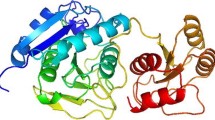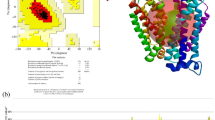Abstract
The pathogen Legionella longbeachae is a causative agent of legionellosis. The antibiotic resistance is the major problem of this modern world. Thus, selective pressure warrants the need for identification of newer drug target. In current study, subtractive proteomics approach screen out SIS (sugar isomerase) domain protein as an attractive receptor molecule for rational drug design. This protein is involved in lipopolysaccharide biosynthesis and catalyzes the isomerization of sedoheptulose 7-phosphate in d-glycero-d-manno-heptose 7-phosphate. Molecular docking revealed compound 1 (2-(6-(N,N-dimethyl sulfamoyl)pipridin-4-yl)pyrazin-2-yl)imidazol-3-ium-1-ide) as the potent inhibitor having GOLD fitness score of 69. The complex is affirmed by half-site effect via simulation analysis. Complex stability was investigated via several approaches that follows dynamic simulation and binding energies. Trajectory analysis revealed slight change in ring positioning of inhibitor inside the active pocket during 130 ns (nanosecond). Interestingly, it was affirmed via binding interactions’ density distribution. Hence, radial distribution function (RDF) inferred that SER55 and SER83 are the major residues that take part in hydrogen bonding and complex stability. Furthermore, an indigenously developed method axial frequency distribution (AFD) has revealed that ligand moved closer to the active site with both the residues SER55 and SER83 binding to the ligand. The phenomena was observed via rotating motion with respect to receptor center cavity. Thus, inhibitor movement towards allosteric site was observed at the end of simulations. Finally, binding free energy calculations by MMPB/GBSA predicts high compound affinity for the complex. Hence, findings from the current study will aid in the novel drug discovery and future experimental studies.

Graphical abstract



















Similar content being viewed by others
References
Kotloff KL, Winickoff JP, Ivanoff B et al (1999) Global burden of Shigella infections: implications for vaccine development and implementation of control strategies. Bull World Health Organ 77:651–666
O’Neill J (2014) Antimicrobial resistance: tackling a crisis for the health and wealth of nations. Rev Antimicrob Resist 20:1–16
D’Costa VM, King CE, Kalan L et al (2011) Antibiotic resistance is ancient. Nature 477:457–461. https://doi.org/10.1038/nature10388
Alekshun MN, Levy SB (2007) Molecular mechanisms of antibacterial multidrug resistance. Cell 128:1037–1050. https://doi.org/10.1016/j.cell.2007.03.004
Blasco MD, Esteve C, Alcaide E (2008) Multiresistant waterborne pathogens isolated from water reservoirs and cooling systems. J Appl Microbiol 105:469–475. https://doi.org/10.1111/j.1365-2672.2008.03765.x
Newton HJ, Ang DKY, van Driel IR, Hartland EL (2010) Molecular pathogenesis of infections caused by Legionella pneumophila. Clin Microbiol Rev 23:274–298. https://doi.org/10.1128/CMR.00052-09
Sci-Hub | Legionella longbeachae and Legionellosis | 10.3201/eid1704.100446. https://sci-hub.tw/https://www.ncbi.nlm.nih.gov/pmc/articles/PMC3377390/. Accessed 31 Aug 2018
Fields BS, Benson RF, Besser RE (2002) Legionella and Legionnaires disease: 25 years of investigation. Clin Microbiol Rev 15:506–526. https://doi.org/10.1128/CMR.15.3.506-526.2002
Weinberg GA, Buchanan AM (2008) Other infectious agents. Pediatric Respiratory Medicine. Elsevier, Amsterdam, pp 639–659
Raetz CRH, Whitfield C (2002) Lipopolysaccharide endotoxins. Annu Rev Biochem 71:635–700. https://doi.org/10.1146/annurev.biochem.71.110601.135414
Taylor PL, Blakely KM, de Leon GP et al (2008) Structure and function of sedoheptulose-7-phosphate isomerase, a critical enzyme for lipopolysaccharide biosynthesis and a target for antibiotic adjuvants. J Biol Chem 283:2835–2845. https://doi.org/10.1074/jbc.M706163200
Wright GD, Sutherland AD (2007) New strategies for combating multidrug-resistant bacteria. Trends Mol Med 13:260–267. https://doi.org/10.1016/j.molmed.2007.04.004
Huang Y, Niu B, Gao Y et al (2010) CD-HIT suite: a web server for clustering and comparing biological sequences. Bioinformatics 26:680–682. https://doi.org/10.1093/bioinformatics/btq003
Li W, Godzik A (2006) Cd-hit: a fast program for clustering and comparing large sets of protein or nucleotide sequences. Bioinformatics 22:1658–1659. https://doi.org/10.1093/bioinformatics/btl158
Zhang R, Ou H-Y, Zhang C-T (2004) DEG: a database of essential genes. Nucleic Acids Res 32:D271–D272. https://doi.org/10.1093/nar/gkh024
Wishart DS, Knox C, Guo AC et al (2008) DrugBank: a knowledgebase for drugs, drug actions and drug targets. Nucleic Acids Res 36:D901–D906. https://doi.org/10.1093/nar/gkm958
Yu C-S, Hwang J-K (2008) Prediction of protein subcellular localizations. 2008 Eighth International Conference on Intelligent Systems Design and Applications. IEEE, pp 165–170
Hassan A, Naz A, Obaid A et al (2016) Pangenome and immuno-proteomics analysis of Acinetobacter baumannii strains revealed the core peptide vaccine targets. BMC Genomics 17:732. https://doi.org/10.1186/s12864-016-2951-4
Azam SS, Shamim A (2014) An insight into the exploration of druggable genome of Streptococcus gordonii for the identification of novel therapeutic candidates. Genomics 104:203–214. https://doi.org/10.1016/j.ygeno.2014.07.007
Webb B, Sali A (2014) Comparative protein structure modeling using MODELLER. Curr Protoc Bioinformatics 47:5.6.1–5.632. https://doi.org/10.1002/0471250953.bi0506s47
Schwede T, Kopp J, Guex N, Peitsch MC (2003) SWISS-MODEL: an automated protein homology-modeling server. Nucleic Acids Res 31:3381–3385. https://doi.org/10.1093/nar/gkg520
Yang J, Yan R, Roy A et al (2015) The I-TASSER suite: protein structure and function prediction. Nat Methods 12:7–8. https://doi.org/10.1038/nmeth.3213
Kelley LA, Mezulis S, Yates CM et al (2015) The Phyre2 web portal for protein modeling, prediction and analysis. Nat Protoc 10:845–858. https://doi.org/10.1038/nprot.2015.053
Laskowski RA, Moss DS, Thornton JM (1993) Main-chain bond lengths and bond angles in protein structures. J Mol Biol 231:1049–1067. https://doi.org/10.1006/jmbi.1993.1351
Eisenberg D, Lüthy R, Bowie JU (1997) VERIFY3D: Assessment of protein models with three-dimensional profiles. Methods Enzymol. 277:396–404. https://doi.org/10.1016/s0076-6879(97)77022-8
Colovos C, Yeates TO (1993) Verification of protein structures: patterns of nonbonded atomic interactions. Protein Sci 2:1511–1519. https://doi.org/10.1002/pro.5560020916
Baseer S, Ahmad S, Ranaghan KE, Azam SS (2017) Towards a peptide-based vaccine against Shigella sonnei: a subtractive reverse vaccinology based approach. Biologicals 50:87–99. https://doi.org/10.1016/j.biologicals.2017.08.004
Iqbal S, Shamim A, Azam SS, Wadood A (2016) Identification of potent inhibitors for chromodomain-helicase- DNA-binding protein 1-like through moleculardocking studies. Med Chem Res 25:2924–2939. https://doi.org/10.1007/s00044-016-1712-x
Huang B (2009) MetaPocket: a meta approach to improve protein ligand binding site prediction. OMICS 13:325–330. https://doi.org/10.1089/omi.2009.0045
Pettersen EF, Goddard TD, Huang CC et al (2004) UCSF chimera—a visualization system for exploratory research and analysis. J Comput Chem 25:1605–1612. https://doi.org/10.1002/jcc.20084
Verdonk ML, Cole JC, Hartshorn MJ et al (2003) Improved protein-ligand docking using GOLD. Proteins 52:609–623. https://doi.org/10.1002/prot.10465
Jones G, Willett P, Glen RC et al (1997) Development and validation of a genetic algorithm for flexible docking. J Mol Biol 267:727–748. https://doi.org/10.1006/jmbi.1996.0897
Humphrey W, Dalke A, Schulten K (1996) VMD: visual molecular dynamics. J Mol Graph 14(33–8):27. https://doi.org/10.1016/0263-7855(96)00018-5
Systèmes D (2016) BIOVIA, discovery studio modeling environment. San Diego, Dassault Systèmes Biovia
Wadood A, Ghufran M, Hassan SF et al (2017) In silico identification of promiscuous scaffolds as potential inhibitors of 1-deoxy-d-xylulose 5-phosphate reductoisomerase for treatment of Falciparum malaria. Pharm Biol 55:19–32. https://doi.org/10.1080/13880209.2016.1225778
Daina A, Michielin O, Zoete V (2017) SwissADME: a free web tool to evaluate pharmacokinetics, drug-likeness and medicinal chemistry friendliness of small molecules. Sci Rep 7:42717. https://doi.org/10.1038/srep42717
Pearlman DA, Case DA, Caldwell JW et al (1995) AMBER, a package of computer programs for applying molecular mechanics, normal mode analysis, molecular dynamics and free energy calculations to simulate the structural and energetic properties of molecules. Comput Phys Commun 91:1–41. https://doi.org/10.1016/0010-4655(95)00041-D
Pastor RW, Brooks BR, Szabo A (1988) An analysis of the accuracy of Langevin and molecular dynamics algorithms. Mol Phys 65:1409–1419. https://doi.org/10.1080/00268978800101881
Kräutler V, van Gunsteren WF, Hünenberger PH (2001) A fast SHAKE algorithm to solve distance constraint equations for small molecules in molecular dynamics simulations. J Comput Chem 22:501–508. https://doi.org/10.1002/1096-987X(20010415)22:5<501::AID-JCC1021>3.0.CO;2-V
Andersen HC (1980) Molecular dynamics simulations at constant pressure and/or temperature. J Chem Phys 72:2384. https://doi.org/10.1063/1.439486
Roe DR, Cheatham TE (2013) PTRAJ and CPPTRAJ: software for processing and analysis of molecular dynamics trajectory data. J Chem Theory Comput 9:3084–3095. https://doi.org/10.1021/ct400341p
Ul Haq F, Abro A, Raza S et al (2017) Molecular dynamics simulation studies of novel β-lactamase inhibitor. J Mol Graph Model 74:143–152. https://doi.org/10.1016/j.jmgm.2017.03.002
Abbasi S, Raza S, Azam SS et al (2016) Interaction mechanisms of a melatonergic inhibitor in the melatonin synthesis pathway. J Mol Liq 221:507–517. https://doi.org/10.1016/j.molliq.2016.06.034
Azam SS, Abro A, Raza S (2015) Binding pattern analysis and structural insight into the inhibition mechanism of sterol 24-C methyltransferase by docking and molecular dynamics approach. J Biomol Struct Dyn 33:2563–2577. https://doi.org/10.1080/07391102.2014.1002423
Miller BR, McGee TD, Swails JM et al (2012) MMPBSA.py: an efficient program for end-state free energy calculations. J Chem Theory Comput 8:3314–3321. https://doi.org/10.1021/ct300418h
Abro A, Azam SS (2016) Binding free energy based analysis of arsenic (+3 oxidation state) methyltransferase with S-adenosylmethionine. J Mol Liq 220:375–382. https://doi.org/10.1016/j.molliq.2016.04.109
Weiser J, Shenkin PS, Still WC (1999) Approximate atomic surfaces from linear combinations of pairwise overlaps (LCPO). J Comput Chem 20:217–230. https://doi.org/10.1002/(SICI)1096-987X(19990130)20:2<217::AID-JCC4>3.0.CO;2-A
Sali A, Blundell TL (1993) Comparative protein modelling by satisfaction of spatial restraints. J Mol Biol 234:779–815. https://doi.org/10.1006/jmbi.1993.1626
Lionta E, Spyrou G, Vassilatis DK, Cournia Z (2014) Structure-based virtual screening for drug discovery: principles, applications and recent advances. Curr Top Med Chem 14:1923–1938. https://doi.org/10.2174/1568026614666140929124445
Durrant JD, McCammon JA (2011) Molecular dynamics simulations and drug discovery. BMC Biol 9:71. https://doi.org/10.1186/1741-7007-9-71
Fernandes J, Gattass CR (2009) Topological polar surface area defines substrate transport by multidrug resistance associated protein 1 (MRP1/ABCC1). J Med Chem 52:1214–1218. https://doi.org/10.1021/jm801389m
Nisha CM, Kumar A, Nair P et al (2016) Molecular docking and in silico ADMET study reveals acylguanidine 7a as a potential inhibitor of β-secretase. Adv Bioinforma 2016:9258578. https://doi.org/10.1155/2016/9258578
Nganou C, Kennedy SD, McCamant DW (2016) Disagreement between the structure of the dTpT thymine pair determined by NMR and molecular dynamics simulations using amber 14 force fields. J Phys Chem B 120:1250–1258. https://doi.org/10.1021/acs.jpcb.6b00191
Karplus M, Kuriyan J (2005) Molecular dynamics and protein function. Proc Natl Acad Sci U S A 102:6679–6685. https://doi.org/10.1073/pnas.0408930102
Biemann HP, Koshland DE (1994) Aspartate receptors of Escherichia coli and Salmonella typhimurium bind ligand with negative and half-of-the-sites cooperativity. Biochemistry 33:629–634. https://doi.org/10.1021/bi00169a002
Bloom CR, Kaarsholm NC, Ha J, Dunn MF (1997) Half-site reactivity, negative cooperativity, and positive cooperativity: quantitative considerations of a plausible model. Biochemistry 36:12759–12765. https://doi.org/10.1021/bi970762f
Vivoli M, Pang J, Harmer NJ (2017) A half-site multimeric enzyme achieves its cooperativity without conformational changes. Sci Rep 7:16529. https://doi.org/10.1038/s41598-017-16421-2
Funding
This study was supported financially by Pak US STCP (2017/360) and Higher Education Commission (HEC), Pakistan.
Author information
Authors and Affiliations
Corresponding author
Ethics declarations
Conflict of interest
The authors declare that they have no conflict of interest.
Additional information
Publisher’s note
Springer Nature remains neutral with regard to jurisdictional claims in published maps and institutional affiliations.
Electronic supplementary material
ESM 1
(DOCX 14 kb)
Rights and permissions
About this article
Cite this article
Ahmad, F., Shabaz, Z. & Azam, S.S. Insight into natural inhibitors and bridging docking to dynamic simulation against sugar Isomerase (SIS) domain protein. J Mol Model 26, 221 (2020). https://doi.org/10.1007/s00894-020-04475-5
Received:
Accepted:
Published:
DOI: https://doi.org/10.1007/s00894-020-04475-5




